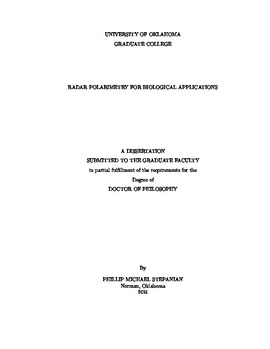| dc.description.abstract | Radar aeroecology has steadily progressed since its inception in the 1950's, and additional advancements in radar technology, networks, modeling, and validation continue to drive the science further. As human impacts steadily increase within the airspace and across the landscape, conflicts with wildlife will motivate new solutions for mitigating these negative interactions. As one of the few sources of widespread surveillance of the aerosphere, radar will continue to play a valuable role in observing and quantifying animal life aloft.
The United States' next-generation weather radar network (NEXRAD) provides national coverage of the airspace at ten-minute resolution. These data are quality controlled, archived, and freely available for download, resulting in an efficient source of animal observations. The NEXRAD weather surveillance radars have recently been upgraded to dual-polarizations, yielding three additional routine data products: differential reflectivity (ZDR), differential phase (phiDP), and co-polar cross-correlation coefficient (rhoHV). While much speculation has been generated over the application of these products to biological studies, little work has been done on the subject.
The topic of this dissertation is the application of NEXRAD to biological studies, specifically focusing on the interpretation and use of polarimetric radar products. An overview of the polarimetric products is presented, and their biological interpretation is outlined. Laboratory radio scattering measurements are detailed, providing a technique for characterizing the radar characteristics of individuals. Typical manifestations of biological scatter are shown, including the roost emergences of bats and birds, as well as widespread nocturnal migration. From these polarimetric signatures in widespread migration, a method is developed that extracts profiles of migrant height orientations by exploiting morphological patterns in rhoHV. Finally, two validation methods are described using radar simulation and passive acoustic localization of nocturnal fight calls. | en_US |
